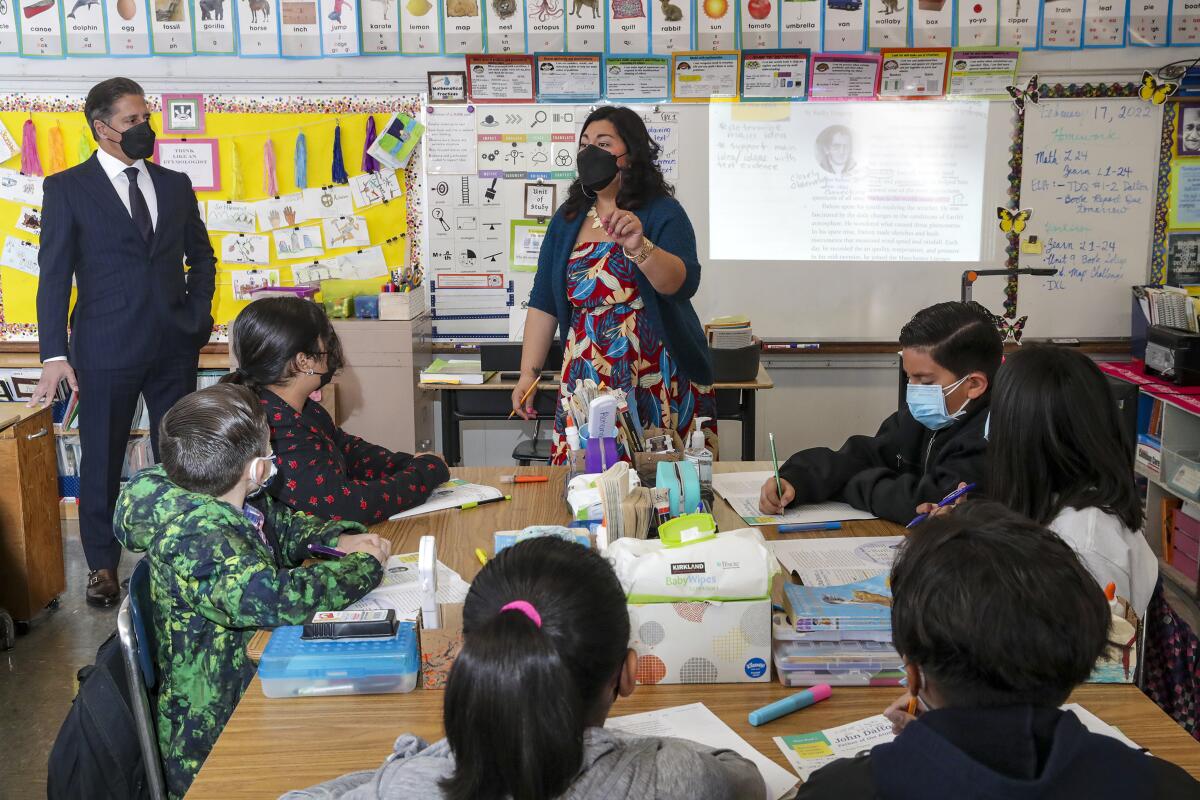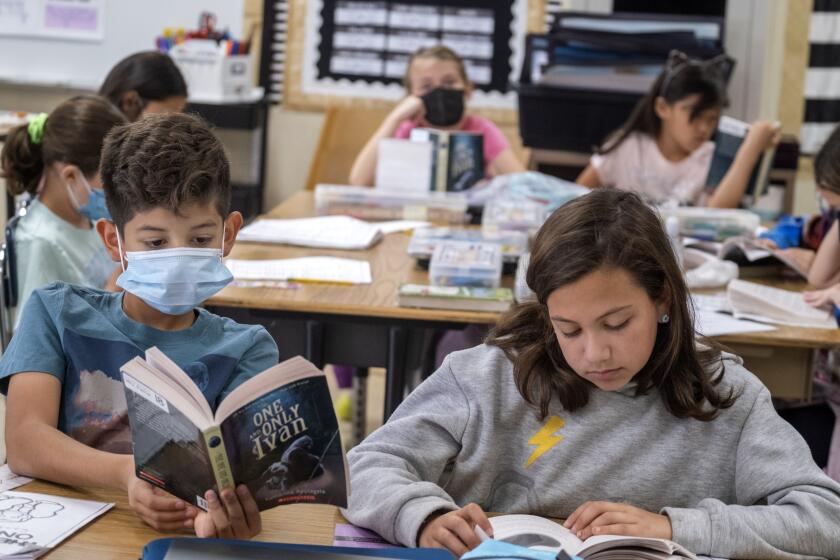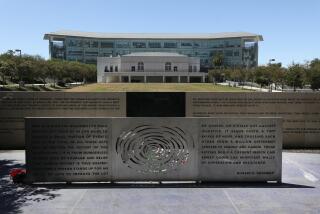LAUSD expects enrollment to plummet by ‘alarming’ 30% in the next decade

- Share via
Enrollment in Los Angeles public schools is expected to plunge by nearly 30% over the next decade, leading to tough choices ahead about academic programs, campus closures, jobs and employee benefits — and forcing, over that time, a dramatic remake of the nation’s second-largest school system.
The predicted steep drop, which was outlined Tuesday in a presentation to the Board of Education, comes as school officials contemplate the future of Los Angeles Unified School District on several crucial fronts — including contract negotiations with the teachers union, which is seeking a 20% raise over the next two years.
District leaders also are trying to plan for the best use of historically high education funding that some experts warn is likely to be short-lived.
“There are a number of unsustainable trends,” said Supt. Alberto Carvalho, referring to declining enrollment and unstable funding. “The perfect storm is brewing.
“Los Angeles Unified is facing an alarming convergence and acceleration of enrollment decline and the expiration of one-time state and federal dollars, as well as ongoing and increasing financial liabilities.”
Carvalho warned the board that difficult conversations lie ahead and there is “not an easy path toward financial stability.”
Enrollment has been incrementally dropping in L.A. Unified since peaking at about 737,000 students 21 years ago. That long-ago overcrowding detracted from the quality and even quantity of education — as campuses operated year-round with students on staggered schedules that provided 17 fewer days of instruction per year and limited access to advanced classes.
The current enrollment is about 430,000 in kindergarten through 12th grade and is expected to fall about 3.6% a year to an estimated 309,000 nine years from now.
Large urban districts, including L.A. Unified, accounted for about one-third of the decline.
The pace of the decline has accelerated since the pandemic, a phenomenon officials struggle to explain. At the start of the pandemic, many families kept preschoolers and kindergarteners out of remote learning — preferring not to plant their children in front of computers for schooling. Yet the pace of decline has persisted even with the resumption of in-person classes.
Declines also are expected over the next nine years in L.A. County (19%) and the state (9%), according to data presented at Tuesday’s meeting.
Experts have offered no conclusive explanation, but factors include families moving to more affordable areas, the decline in birth rates, a drop in immigration and, until recently, the rapid growth of charter schools.
Problems related to the enrollment drop have already surfaced. A handful of campuses — despite their importance as community anchors — have closed or are projected to close. Or, the campuses have been offered to charter schools — which are not operated by the district and compete for students. Many charters are also facing enrollment challenges and some have shut down.
Having fewer students creates financial strains because state and federal funding is based primarily on enrollment. It’s difficult to reduce fixed costs related to buildings and operations as the funding base shrinks. Moreover, decreased funding makes it more challenging to manage pension costs shared by all school systems as well as separate lifetime retiree health benefits that L.A. Unified has provided to long-term employees.
In the coming years, under the current structure, there could be more L.A. Unified retirees and dependents receiving healthcare benefits than active employees, said Chief Financial Officer David Hart.
“That was never contemplated,” Hart said.
At the same time, the district has struggled this year with a shortage of qualified employees in teaching, nursing, counseling and other areas. To attract and retain such workers, it would help for the district to pay higher salaries — and to continue funding strong health benefits.
Having sufficient money to spend, it would seem, ought to be the least of the district’s challenges, given Gov. Gavin Newsom‘s announcement last week of the largest budget surplus in state history. The surplus is expected to balloon to $97.5-billion by next summer, an estimate that vastly exceeds previous projections and which is folded into a $300.6-billion budget. About 40% of the budget goes by law to grade schools and community colleges.
When including both state and federal sources, California would spend $22,850 per student in the upcoming academic year, an amount that seemed beyond any expectations not long ago.
In the pandemic’s latest hit on education, the number of L.A. Unified students who have been chronically absent this school year has doubled.
The state budget figures have improved since January, resulting in an extra $60 million to L.A. Unified as an enhanced cost-of-living adjustment. And L.A. Unified also can look to receive other new funding, such as grants set aside to expand early education and “community schools,” which provide school-based services to families.
Even before these new funds land, L.A. Unified expects to end the year with an “unassigned/undesignated” ending balance of more than $1.4 billion.
The teachers union is seeking a raise of equally historic proportions — citing the high cost of living in Southern California. The union proposal also includes additional pay bumps for advanced degrees and mentoring roles and up to $2,000 in reimbursement for credentialing and classes completed to increase wages.
Under the proposal, nurses — who are represented by the teachers union — would get a $20,000 raise to make their salaries more competitive. Union leaders noted that the district has tried but failed to fulfill a contract commitment three years ago to provide a nurse at every campus.
Another significant cost item in the union proposal is a reduction in class sizes and in the ratio of students to counselors, positions that have also gone unfilled this year because of shortages.
Union leaders want to hear no talk of financial doom.
“The district historically under-projects its revenue, over-projects its expenditures,” Jeff Good, the teacher union’s executive director, said at a news conference last week. “The crisis that we are living ... has to be addressed now, and we’re going to push the district to go as far as they can.”
Some district officials had called the previous union contract unaffordable, but it turned out not to be.
However, amid this unprecedented funding comes a warning from the state’s independent Legislative Analyst’s Office. It reported that a simulation of 10,000 possible state revenue scenarios resulted in shortfalls in the state budget 95% of the time in the coming years, largely because of how the state allocates and spends money. In addition, fiscal warning signs that have correctly predicted economic downturns in the past almost uniformly point to a recession in the relatively near future.
And locally, although L.A. Unified has had more jobs available than it can fill over the last year, much of the funding — more than $5 billion — is from one-time COVID-relief aid.
Officials said they will have to decide whether and how to maintain existing academic programs, while also making room for new ones. One such existing effort, Primary Promise, has put an additional teacher into classrooms at struggling schools — and was substantially funded with COVID-relief dollars. That’s an effort officials said they want to continue.
Carvalho said the district will need to make many strategic adjustments, including eliminating overstaffing in some areas outside of the classroom.
The situation embodies a dizzying disconnect, said school board member Nick Melvoin: “It’s either historic investment or the sky is falling, and I think we have to articulate why both can be true maybe at the same time and live with that discomfort.”
Board member Jackie Goldberg said there was no need for employees or parents to feel panic or hopelessness.
“We’re not just talking about the fact that the financial picture is not great,” Goldberg said. “We’re talking about doing something about it before it has problems for this district. We’re not going to wait till it hits us. And that’s good news, not bad news.”
More to Read
Sign up for Essential California
The most important California stories and recommendations in your inbox every morning.
You may occasionally receive promotional content from the Los Angeles Times.













